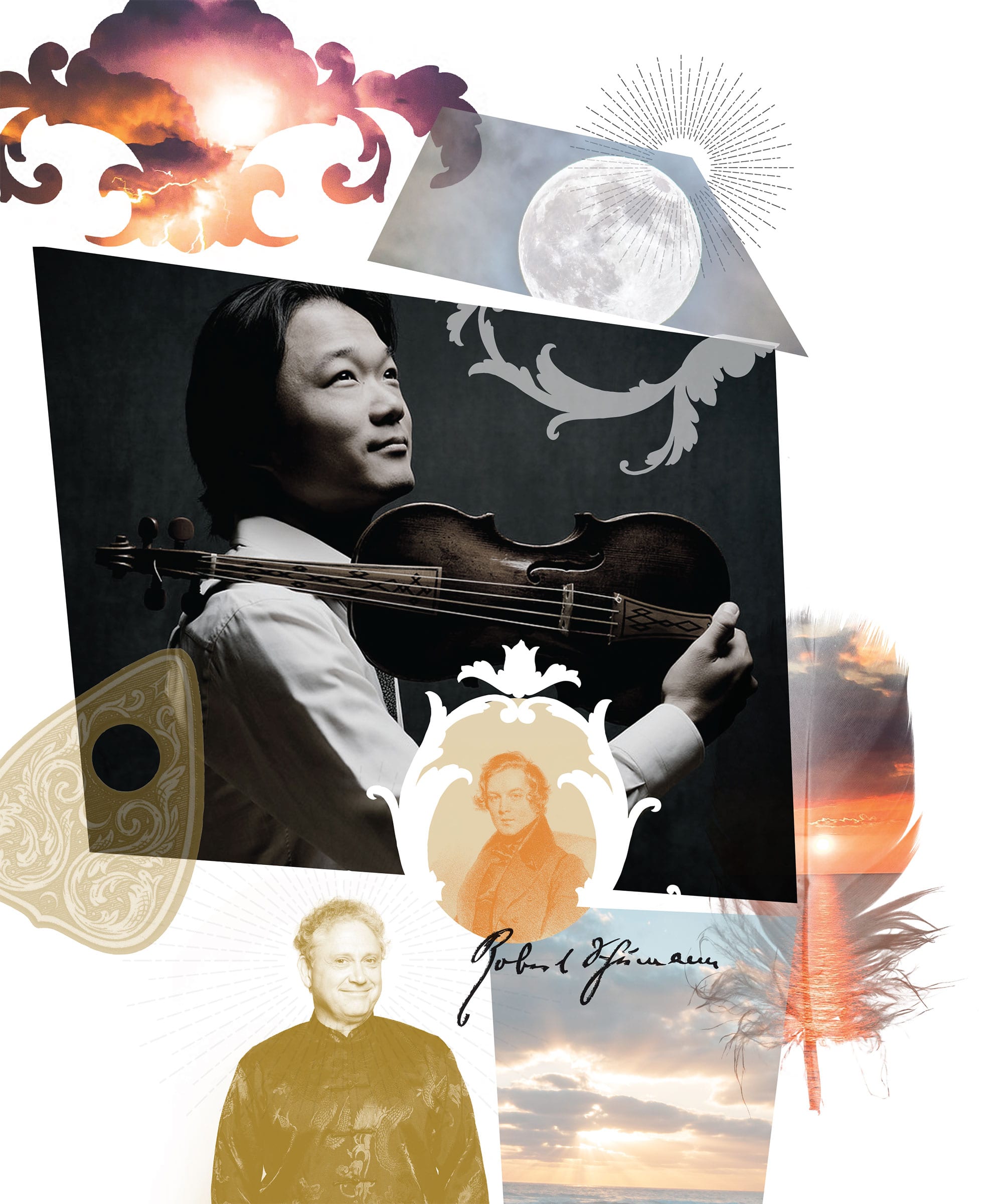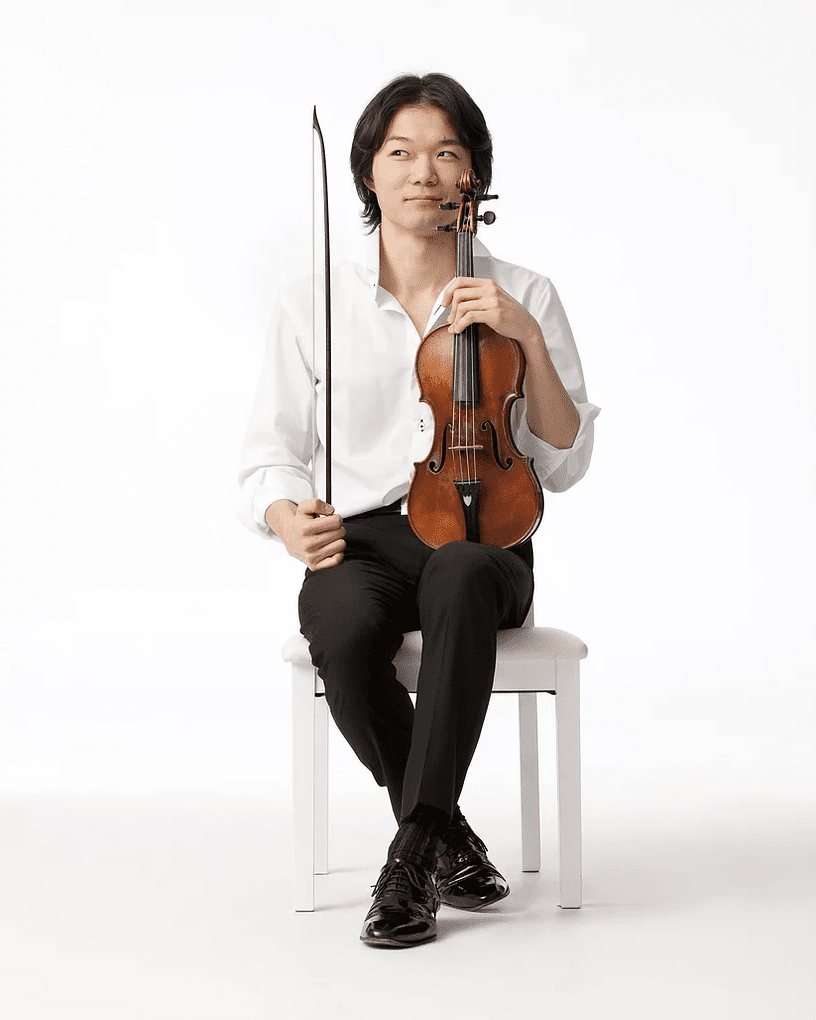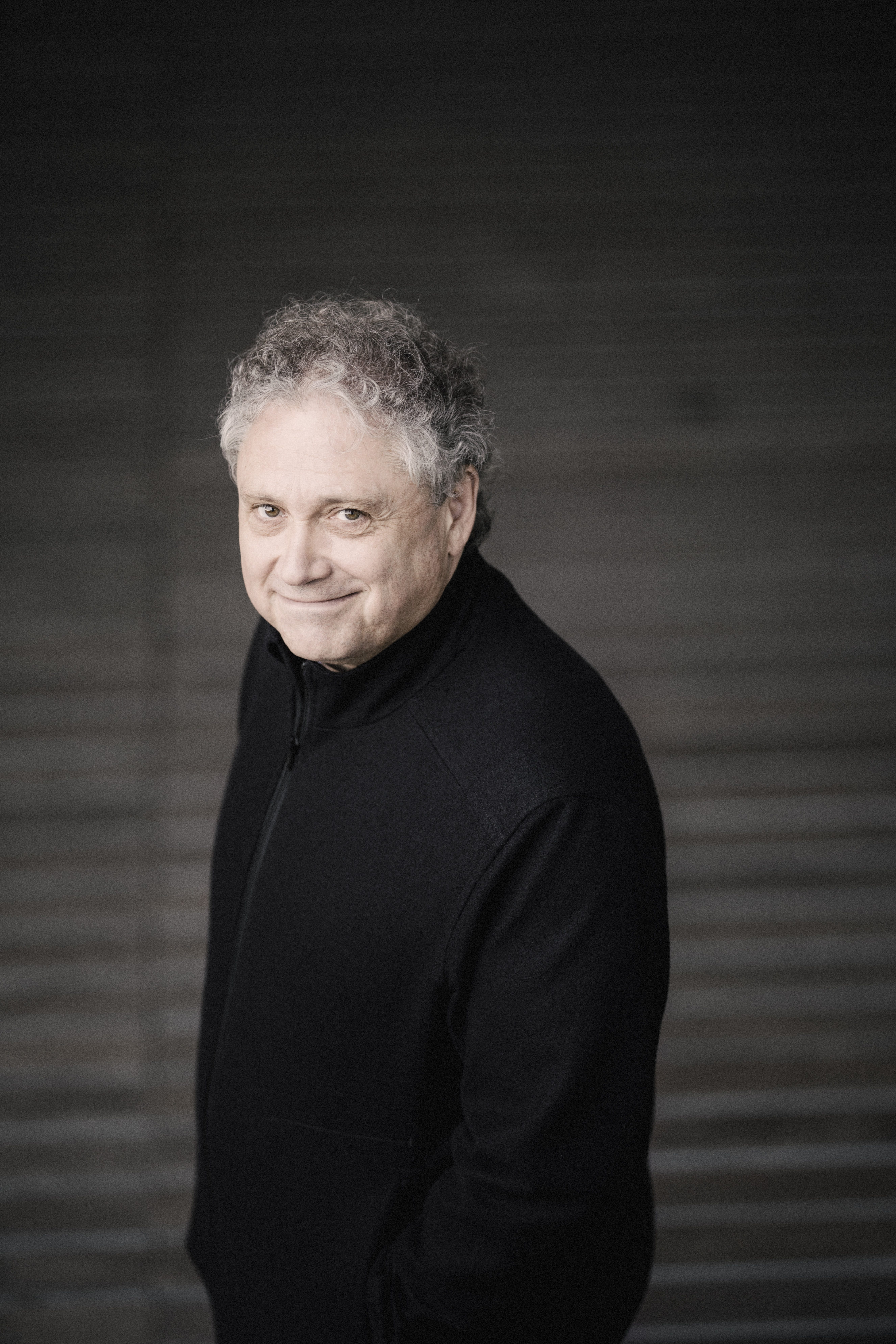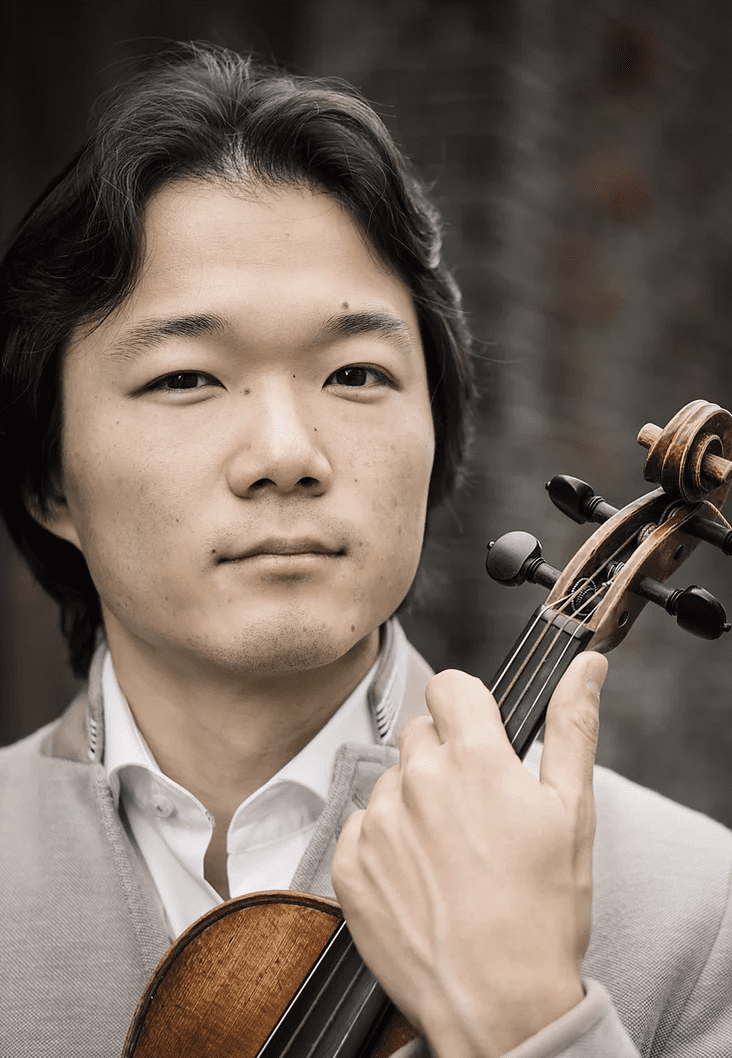
Schumann’s Reawakened Masterpieces
October 14–17, 2021
We finally welcome Music Director Richard Egarr for his first Bay Area performances since his appointment with music from one of the greatest composers of the Romantic era. Added to this joy, we welcome the distinctive and engaging violinist Shunske Sato as he makes his PBO debut.
BACH Fuga a 3 Soggetto, “Unfinished Fugue” from The Art of Fugue
SCHUMANN Concerto for Violin in D minor
SCHUMANN Symphony No. 2 in C Major, Op. 61
Richard Egarr, conductor
Shunske Sato, violin
Philharmonia Baroque Orchestra
Made possible with support from The Bernard Osher Foundation.
”The degree of exquisitely joyful listening has nevertheless completely bowled me over."
Gramophone

About Schumann’s Reawakened Masterpieces
We finally welcome Music Director Richard Egarr for his first Bay Area performances since his appointment with music from one of the greatest composers of the Romantic era. Added to this joy, we welcome the distinctive and engaging violinist Shunske Sato as he makes his PBO debut.
We’ve all read about music that’s been rediscovered thanks to a find on a dusty forgotten shelf, but how about music that has been re-found thanks to a…seance? That’s the alleged story of how Schumann’s forgotten concerto came to be discovered in 1933, with the Swedish Ambassador to London apparently receiving a series of psychic messages as to its whereabouts.
Thanks to their efforts today we can appreciate this work as a fascinating ‘missing link’ between the Beethoven and Brahms concertos, as well for its satisfyingly rich melodies and noble grandeur.
Richard has made the perfect Schumann pairing with his Symphony No. 2, written from 1845 to 1846 as he emerged from a period of “melancholia.” During these years, Schumann looked to the music of J.S. Bach as a restorative balm, devoting himself to the study of counterpoint and the result is this triumphant masterpiece, a fantastic showcase for the orchestra.
Throughout his adult life, Schumann experienced bouts of serious depression, but he was able to muster the most positive elements of Romanticism into his music. His life was a struggle, yet in his music we sense light. This well known work will shed a bright light as we experience that inexplicable rush we get when we come together to share live music.
The Music
BACH Fuga a 3 Soggetti, “Unfinished Fugue” from The Art of Fugue
SCHUMANN Concerto for Violin in D minor, WoO 23
SCHUMANN Symphony No. 2 in C Major, Op. 61
Program Notes
Johann Sebastian Bach (1685-1750)
Fuga a 3 Soggetti, “Unfinished Fugue” from The Art of Fugue, BWV 1080
Johann Sebastian Bach’s intellectual development of harmony laid the foundations for centuries of subsequent music, from Mozart to ABBA. In particular, Bach mastered counterpoint – the braiding of different but complementary musical voices.
The highest manifestation of counterpoint is fugue: the introduction and subsequent discussion of a single theme, at staggered intervals and different pitches, by otherwise independent voices.
Those voices might be individual instruments or the autonomous fingers of a keyboard player. Bach didn’t specify which instrument (or instruments) should relay his culminating contrapuntal manifesto, The Art of Fugue.
In this collection, started at as early as 1742 but assembled later into a fully comprehensive set, the composer sought to create a unified but diverse encyclopaedia of fugal techniques. He did so mostly using the same melody or ‘fugue subject’, based on a simple D minor chord. As always, Bach’s rigorous logic led to music both exuberant and profound.
Two fugues by Bach bear strong associations with the Art of Fugue set and were published with it, even if a cast-iron link with the composer’s overall project cannot be verified. The most famous is this fugue, which doesn’t ostensibly use the D minor fugue subject. Many musicians have noticed, however, that its three themes could easily be combined with that Subject.
More tantalising is that Bach apparently died while committing this music to the page. Shortly after we hear the emergence of theme based on the motto associated with the name Bach (B flat, A, C, B natural), the music tails off. ‘At the point where the composer introduces the name BACH in the countersubject to this fugue,’ reads a note on the manuscript, in the handwriting of Bach’s son Carl Philipp Emanuel, ‘the composer died.’
Robert Schumann (1810-1856)
Concerto for Violin in D minor, WoO 23
In the Spring of 1853, Robert Schumann saw the great virtuoso Joseph Joachim play Beethoven’s Violin Concerto. The performance made a deep impression on the composer and prompted him to write two works for violin and orchestra with 18 Joachim in mind. One was this violin concerto, started on 21 September 1853, finished on 1 October, and fully orchestrated two days later.
Joachim, though, wasn’t too impressed with Schumann’s efforts, which is where an extraordinary story begins. The violinist acted to stop the concerto being published with the support of Brahms; neither believed the score worthy of Schumann’s name (a combination of Brahms’s cripplingly unrealistic perfectionism and Joachim’s lack of judgment). Joachim squirreled the score away in the Prussian State Library.
Seven decades later, another violinist enters the picture. Jelly d’Aranyi was Joachim’s great niece, and a London violinist with a penchant for the supernatural. D’Aranyi claimed to have heard of the forgotten concerto’s existence when Schumann himself spoke to her from the grave during a Ouija Board session. D’Aranyi spread the word and before long the manuscript stashed by Joachim was hunted down. The concerto was given its belated premiere in Berlin, after which D’Aranyi, the BBC Symphony Orchestra and Sir Adrian Boult played the piece on 16 February 1938 in London.
Eager to align themselves with the reputable figures of Brahms and Joachim, critics pointed to the work’s structural weaknesses. In a sense, they got to the bottom of it: the concerto’s relationship with traditional sonata form is uneasy and Schumann doesn’t always appear to develop his themes as a composer of his stature would have been expected to. They pointed, too, to a general lack of drama and a profusion of irritating repetition. The counterargument is that this is simply Schumann’s conscious late style: shorter lines, more distinctive gestures, greater asymmetry and, through them all, a general avoidance of sentimentality.
These days, it’s easier to hear the Violin Concerto as ‘different’ rather than ‘sub-standard’. The musicologist Alfred Nieman has noted Schumann’s lack of interest in pitting clashing opposites against one another, as most Romantic concertos were wont to do. Instead, writes Nieman, Schumann’s themes should be heard ‘as if characters in a play, forming new alignments in varying scenes but seldom drastically changing their basic personalities.’ In his first movement, Schumann fashions a traditional opening structure that’s eclipsed by his very different-sounding themes. Two are presented by the orchestra before the soloist has played a note; towards the middle of the movement, Schumann appears to deconstruct one of them as the orchestra and soloist trade short chords and delicate arpeggios in a moment of curious fragility.
The theme of the slow movement is particularly touching (Brahms used it as the basis for another set of variations) not least when, towards the end of the movement, we hear it in a completely different light: shifted down a third and suddenly in a minor key. A short transition leads to the final movement, a cheerful Polonaise in which three themes are recalled no less than five times. All, however, is not jolly. At one point the music glances fleetingly over its shoulder, recalling the main musical idea of the slow movement in what seems to be a moment of sudden, chilling fear. Did Schumann sense what was coming his way?
Robert Schumann (1810-1856)
Symphony No. 2 in C Major, Op. 61
Mental illness crippled Schumann for much of his later life. The composer started to experience bouts of serious depression at the end of the 1820s. He made his first attempt at suicide in 1833, jumping from the window of his fourth-floor apartment.
In 1844, the composer’s mental and physical wellbeing fell into a tailspin. He periodically shied away from music entirely, claiming that simply to hear it ‘cut into my nerves with knives.’ Earlie r that decade, Schumann’s wife Clara recalled, she would frequently wake to find her husband ‘swimming in tears’.
By 1845, Schumann was trying desperately to restore order to his life and his mind, setting himself rigorous exercises in counterpoint and copying out scores by Bach and Schubert. As so often, both composers gave Schumann hope, leading him towards an intellectual challenge that he believed could haul him out of the abyss.
In the midst of these counterpoint exercises, Schumann wrote to the composer Felix Mendelssohn. ‘Drums and trumpets in C have been blaring in my head,’ he reported; ‘I have no idea what will come of it.’ When a new symphony started to make its way from Schumann’s head onto paper in December 1845, the process proved more difficult than before (‘all writing is a severe strain on me,’ wrote Schumann to Mendelssohn). Still, the symphony that was taking shape did have a particularly prominent feature: drums and trumpets in the key of C—the key of Schubert’s own ‘Great’ Symphony No 9.
Those instruments, and that key, brought defiant, joyous and even spiritual overtones to the symphony. When the work was first performed on 5 November 1846 in Leipzig, conducted by Mendelssohn and billed as Schumann’s Symphony No 2 (he had actually finished two symphonies before it), some critics sensed a distinctly religious dimension to the work. Chorales float through three of the four movements and the motto that clearly emerges has a stately gait.
Even more noteworthy is the development of thematic cross-referencing between movements and the channeling of four contrasting chapters into a single, unmistakable idea. That idea may not be a reflection of mental disorder, but it is certainly one of hard-won affirmation—musical and personal.
A slow introduction spells out the symphonic motto: a fanfare traced by brass through a fog of strings. It will return at strategic points along the symphony’s journey, crowning the first three movements and bestowing a benediction on the fourth. The latter part of this introduction musters the dotted rhythms that power the development forward in the Allegro section. In the movement’s expanse, we might be hearing the residue of Schumann’s work on Schubert’s ‘Great’.
If Schubert is there in between the notes, Bach is literally spelt out by them. The energy changes in the Scherzo. It contains two separate trio sections, the latter picking out the Bach ‘motto’ heard in the Art of Fugue (B flat, A, C , B natural) before inverting them as if to make the point. The motto returns at the last, as it does in the noble Adagio, a moment of deep reflection built on a wide-stepping melody. It drifts into the beginnings of a fugue, but is infused with too much serenity to want to work its own suggested counterpoint out.
Schumann’s finale sees all those ideas transformed. Characteristic dotted rhythms return to give the music the exuberance of its antecedents, with even the slow movement’s melody weaving itself into a discourse on all that has been heard so far.
Just when we expect the convergence of the materials (and the shift back to C major) to carry the symphony home, the music metamorphoses into something else entirely. The oboe quotes a melody from Schumann’s own Piano Fantasy, itself shaped by a line from Beethoven’s song cycle An die ferne Geliebte that marks the words ‘take, then, these songs of mine’.
This is surely Schumann’s message to his wife Clara, the recipient of a flood of post-nuptial songs in the 1840s. From its haunting appearance, the theme beds into the music and is ultimately entwined with the fanfare motto, not so much restoring the music’s confidence as filling it with an entirely new optimism.
In a letter to the composer Georg Dietrich Otten, Schumann was blunt. ‘I wrote the symphony…when I was unwell,’ he stated. ‘I feel that people are bound to notice this when they hear the work. I began to feel more myself when I wrote the last movement, but it was only after I had completed the whole score that I felt any better. All the same it reminds me of a black period.’
Part of that black period involved a trip, with Clara, to the Saxon district of Maxen. Schumann was deeply into his conceptual preparation of the symphony at the time, and the couple found themselves staying next door to a hospital for the mentally ill. Schumann became overwhelmed with paranoia, sensing the inevitability of his demise and prophesizing that he would end his days in such an institution. His fears were well founded. He was committed to an asylum in 1854 and died there two years later.
The Nazis and Schumann’s Violin Concerto
‘Never shall I forget the moment when my mother came in to us and said, with deep but suppressed emotion on her face, “I have just settled with Joachim and Johannes [Brahms] that the concerto is not to be published, not now, or at any time”’. So recalled Schumann’s youngest daughter Eugenie in an interview with The Times in 1938, a few days before the Violin Concerto’s UK premiere.
Just one year before, Jelly d’Aranyi’s psychic gifts had led researchers to the Prussian State Library where the unknown Violin Concerto in Eugenie’s father’s hand lay. D’Aranyi’s original plan had been to perform the concerto in London in October 1937, but there was a problem. The Nazis had claimed ownership of the score and its copyright, citing its existence a state-controlled library.
There appeared to be an impasse. But d’Aranyi and the conductor Sir Adrian Boult were determined. Diplomatic wheels were set in motion, which involved an act of remarkable appeasement given all-out war was just two years away. With the agreement that the violinist Georg Kulenkampff could present the world premiere of the piece in Berlin in late 1937, D’Aranyi and Boult got the London premiere and radio broadcast they wanted.
Program notes by Andrew Mellor © 2021
Pre-Concert Conversations
Join Composer in Residence Tarik O’Regan and Richard Egarr forty-five minutes before each concert for fun and informative discussions on the works, performing on period instruments, and more about Richard’s vision for PBO



